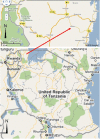Ethnomedicine of the Kagera Region, north western Tanzania. Part 2: The medicinal plants used in Katoro Ward, Bukoba District
- PMID: 20663166
- PMCID: PMC3224970
- DOI: 10.1186/1746-4269-6-19
Ethnomedicine of the Kagera Region, north western Tanzania. Part 2: The medicinal plants used in Katoro Ward, Bukoba District
Abstract
Background: The Kagera region of north western Tanzania has a rich culture of traditional medicine use and practices. The dynamic inter-ethnic interactions of different people from the surrounding countries constitute a rich reservoir of herbal based healing practices. This study, the second in an ongoing series, reports on the medicinal plant species used in Katoro ward, Bukoba District, and tries to use the literature to establish proof of the therapeutic claims.
Methodology: Ethnomedical information was collected using semi-structured interviews in Kyamlaile and Kashaba villages of Katoro, and in roadside bushes on the way from Katoro to Bukoba through Kyaka. Data collected included the common/local names of the plants, parts used, the diseases treated, methods of preparation, dosage, frequency and duration of treatments. Information on toxicity and antidote were also collected. Literature was consulted to get corroborative information on similar ethnomedical claims and proven biological activities of the plants.
Results: Thirty three (33) plant species for treatment of 13 different disease categories were documented. The most frequently treated diseases were those categorized as specific diseases/conditions (23.8% of all remedies) while eye diseases were the least treated using medicinal plants (1.5% of all remedies). Literature reports support 47% of the claims including proven anti-malarial, anti-microbial and anti-inflammatory activity or similar ethnomedical uses. Leaves were the most frequently used plant part (20 species) followed by roots (13 species) while making of decoctions, pounding, squeezing, making infusions, burning and grinding to powder were the most common methods used to prepare a majority of the therapies.
Conclusion: Therapeutic claims made on plants used in traditional medicine in Katoro ward of Bukoba district are well supported by literature, with 47% of the claims having already been reported. This study further enhances the validity of plants used in traditional medicine in this region as resources that can be relied on to provide effective, accessible and affordable basic healthcare to the local communities. The plants documented also have the potential of being used in drug development and on farm domestication initiatives.
Figures
Similar articles
-
Ethnomedicine of the Kagera Region, north western Tanzania. Part 3: plants used in traditional medicine in Kikuku village, Muleba District.J Ethnobiol Ethnomed. 2012 Apr 4;8:14. doi: 10.1186/1746-4269-8-14. J Ethnobiol Ethnomed. 2012. PMID: 22472473 Free PMC article.
-
The ethnomedicine of the Haya people of Bugabo ward, Kagera Region, north western Tanzania.J Ethnobiol Ethnomed. 2009 Aug 31;5:24. doi: 10.1186/1746-4269-5-24. J Ethnobiol Ethnomed. 2009. PMID: 19715617 Free PMC article.
-
Medicinal plants used to treat "African" diseases by the local communities of Bwambara sub-county in Rukungiri District, Western Uganda.J Ethnopharmacol. 2021 Mar 25;268:113578. doi: 10.1016/j.jep.2020.113578. Epub 2020 Nov 12. J Ethnopharmacol. 2021. PMID: 33189840
-
Ethnomedical uses and pharmacological activities of most prevalent species of genus Piper in Panama: A review.J Ethnopharmacol. 2018 May 10;217:63-82. doi: 10.1016/j.jep.2018.02.008. Epub 2018 Feb 9. J Ethnopharmacol. 2018. PMID: 29428241 Review.
-
Treatment of malaria and related symptoms using traditional herbal medicine in Ethiopia.J Ethnopharmacol. 2018 Mar 1;213:262-279. doi: 10.1016/j.jep.2017.10.034. Epub 2017 Nov 2. J Ethnopharmacol. 2018. PMID: 29102764 Review.
Cited by
-
Ethnomedicinal study of plants used in villages around Kimboza forest reserve in Morogoro, Tanzania.J Ethnobiol Ethnomed. 2012 Jan 6;8:1. doi: 10.1186/1746-4269-8-1. J Ethnobiol Ethnomed. 2012. PMID: 22221935 Free PMC article.
-
Antiasthmatic Medicinal Plants of Tanzania: An Ethnomedicinal and Ethnopharmacological Review.ScientificWorldJournal. 2024 Aug 27;2024:4420431. doi: 10.1155/2024/4420431. eCollection 2024. ScientificWorldJournal. 2024. PMID: 39228457 Free PMC article. Review.
-
Medicinal plants with anti-inflammatory activities from selected countries and regions of Africa.J Inflamm Res. 2018 Aug 7;11:307-317. doi: 10.2147/JIR.S167789. eCollection 2018. J Inflamm Res. 2018. PMID: 30122972 Free PMC article. Review.
-
A comprehensive review of antimalarial medicinal plants used by Tanzanians.Pharm Biol. 2024 Dec;62(1):133-152. doi: 10.1080/13880209.2024.2305453. Epub 2024 Jan 25. Pharm Biol. 2024. PMID: 38270178 Free PMC article.
-
A study of antimicrobial activity, acute toxicity and cytoprotective effect of a polyherbal extract in a rat ethanol-HCl gastric ulcer model.BMC Res Notes. 2012 Oct 2;5:546. doi: 10.1186/1756-0500-5-546. BMC Res Notes. 2012. PMID: 23031266 Free PMC article.
References
-
- Mulokozi MM. The last of the bards: The story of Habibu Selemani of Tanzania (c.1929-93) Research in African Literatures. 1997;28:159–172.
-
- Moshi MJ, Innocent E, Masimba PJ, Otieno DF, Weisheit A, Mbabazi P, Lynes M, Meachem K, Hamilton A, Urassa I. Antimicrobial and brine shrimp toxicity of some plants used in traditional medicine in Bukoba District, north-western Tanzania. Tanzania Journal of Health Research. 2009;11:23–28. - PubMed
-
- Moshi MJ, Innocent E, Magadula JJ, Otieno DF, Weisheit A, Mbabazi PK, Nondo RSO. Brine shrimp toxicity of some plants used as traditional medicines in Kagera region, north western Tanzania. Tanzania Journal of Health Research. 2010;12:63–67. - PubMed
-
- Moshi MJ, Innocent E, Otieno JN, Magadula JJ, Nondo RSO, Otieno DF, Weisheit A, Mbabazi A. Antimicrobial and brine shrimp activity of Acanthus pubescens root extracts. Tanzania Journal of Health Research. 2010;12:171–175.
Publication types
MeSH terms
Substances
LinkOut - more resources
Full Text Sources
Medical


